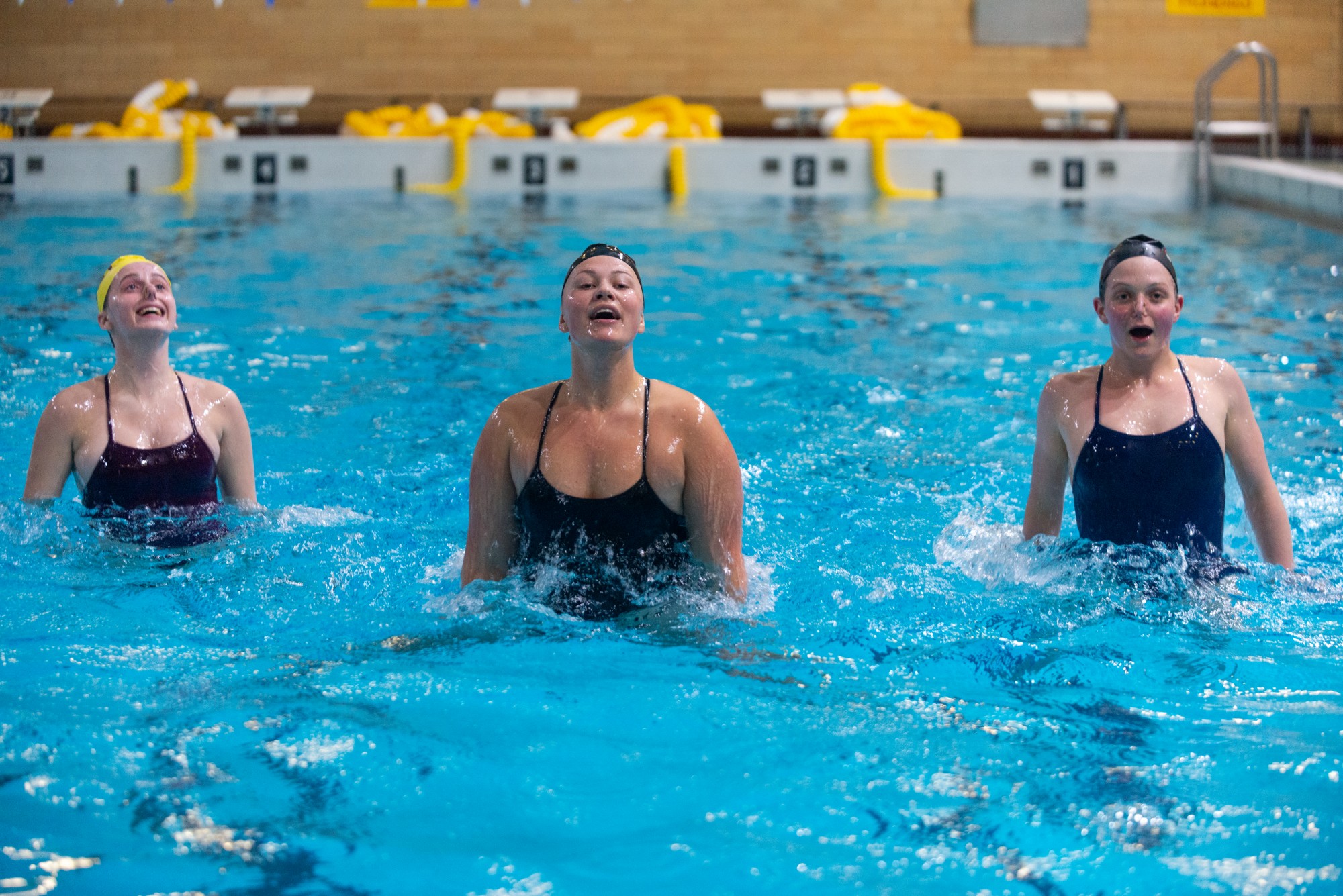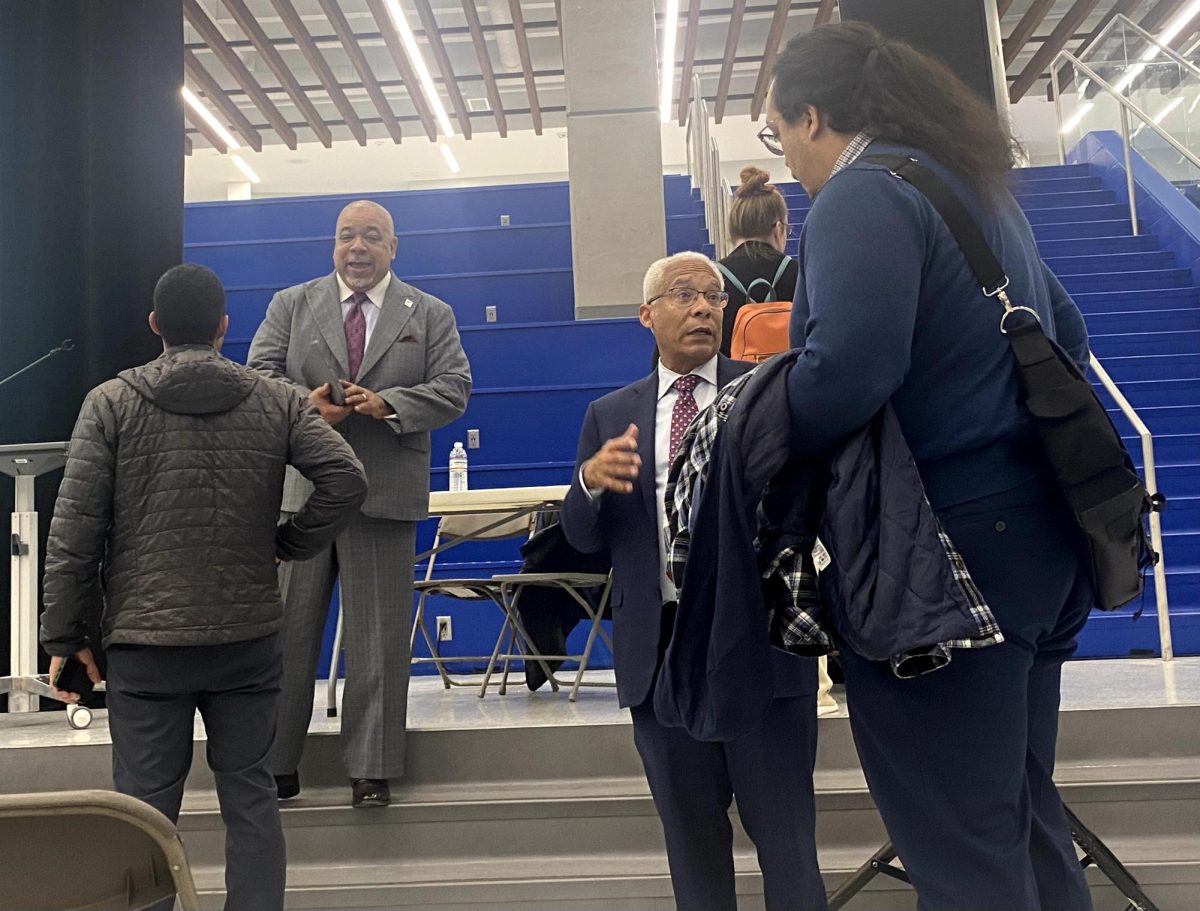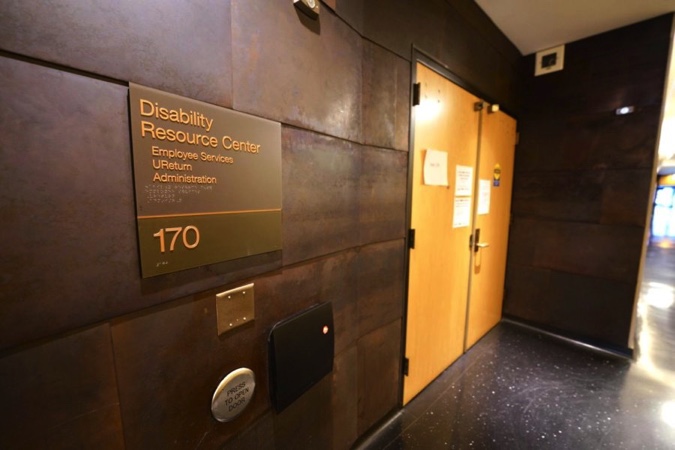Set to music from Kanye West, Fall Out Boy and even a Charlie’s Angels medley, a dozen swimmers weave throughout a Cooke Hall pool while incorporating spins, intricate leg kicks and lifts that see them rise almost completely out of the water.
Swimmers cling to the edge of the pool chatting with each other, taking turns to swim routines for their coaches who watch intently from the deck. After each routine, the head coach gives a detailed critique — noting the angles of limbs, the timing of duet routines and correcting toes that didn’t submerge completely.
In the group’s final practice before regionals, the University of Minnesota Synchronized Swimming Club makes it clear this is not your mother’s (or grandmother’s) synchronized swim team.
Gone are the days of the spectacle and Hollywood glamour that first popularized the activity, which used to consist mostly of floating patterns and graceful swimming strokes. Synchronized swimming, also known as artistic swimming, has transformed from a graceful dance in water to an intensely athletic sport.
Routines are faster and team members swim much closer together — one of the reasons for the sport’s high rate of concussions. Swimmers incorporate more intricate moves into their routines such as lifts, where swimmers are pushed above the water using only their body strength.
The sport is growing more competitive and complex each year, and collegiate teams and clubs are leading that push. As one of the 27 collegiate programs across the nation, the University’s team has been a presence on campus for decades.
While national competitions have been canceled this year due to COVID-19, the team placed second at the Collegiate North Regional Synchronized Swimming Championship this month.
Head coach and former University synchro team member Natalie Bodin credits the team’s success not to an intense training program or practice schedule, but rather camaraderie and an emphasis on fun.
The light-hearted mood helps build trust between teammates, said club president Andrea Dunrud — crucial to a sport that takes place partially underwater.
Strong relationships not only help swimmers work better together, but are vital if something like a lift goes wrong, Bodin said.
But it’s not all intense competition. Sometimes, synchro looks like dancing around to music, which may later be incorporated into choreography, or simply laughing at mistakes.
“Synchro people are the goofiest people I’ve ever met,” Bodin said. “This sport is kinda goofy. It’s weird in nature, so when you mess up… we’re going to laugh and it’s going to be funny.”
Swimmers join the club with varying experience levels and goals — Dunrud has been involved in synchronized swimming since the fourth grade but said most swimmers join in middle school or high school. Coaches look forward to working with every athlete regardless, said Bodin.
“If you’re here to exclusively have fun, that’s fine. If you’re here to get a certain score, I’m here to work with you, let’s make it happen. But let’s also have fun,” she said.
A changing sport
Synchronized swimming first started to emerge in the ‘30s and ‘40s in aquacades — large performances in water that typically incorporated dance and music — and quickly gained popularity in Hollywood, said Michele Kraus, VP of marketing and member services for USA Artistic Swimming, the sport’s national governing body.
“I think it grew because it was a sport for women in the ’60s and ’70s,” said Kraus. “It was so popular in high schools because it would be the answer to the football team for women.”
Since then, the sport has only continued to gain traction.
Because synchro is relatively new compared to other sports, it has seen massive changes in the decades since its origin — it’s becoming more complex, faster, high-risk and acrobatic, she said.
“It’s such a young sport, that you see it change from one year to the next,” said Kraus. “Collegiate teams are pushing the limits of what is possible.”
Bodin also credited collegiate teams with helping push the sport forward, explaining that moves and combinations used even five years ago seem outdated.
Sandy Ness, a member of the University’s team during the early ‘70s, has spent decades coaching and judging synchronized swimming in Minnesota. She’s seen routines evolve from simple moves to fast, advanced choreography. Instead of instrumental music, teams often choose more dramatic and modern songs.
As the sport changes, so do the rules. When teams began incorporating music with lyrics, governing bodies had to create new guidelines that prohibited profanity, Ness said.
One thing that’s stayed consistent over the years? The team’s emphasis on having fun, she said.
“We had the greatest time. It was so much fun to do swimming that we wouldn’t have done before,” Ness said. “I definitely am stuck in synchronized swimming, and it’s a good place to be.”
Close to home
Within Minnesota, younger swimmers can compete on their high school teams and join local groups. Adults can also join the masters team or swim with clubs.
But collegiate swimming is another story.
Besides the University of Minnesota, Hamline University is the only other Minnesota collegiate club. The community is small, but tight-knit, said Dunrud.
The University’s season begins in September and continues through March. While this is historically the team’s busiest month, COVID-19 has forced the team to make adjustments after nationals were canceled.
“We are all disappointed because this was going to be a great year for us for competition,” Bodin said in an email.
But the lack of formal competitions won’t keep the team down. Dunrud, who is graduating this year with a degree in apparel design, said she looks forward to continuing her involvement in the sport and is looking for coaching jobs.
“I am bummed to be graduating,” Dunrud said. “But, it’s fun to invest in new swimmers.”
At the end of practice, swimmers took their time getting out of the pool — some helped reset lane lines while one swimmer tossed a pair of borrowed goggles back to another. After drying off, the group circled around Bodin for final notes of encouragement before heading off to regionals later that week.
“These swimmers are fabulous, they’re fun, they work hard, they do well in school, they’re great leaders. I wouldn’t come and do this if it wasn’t for them,” Bodin said. “They’re what makes this program shine.”













